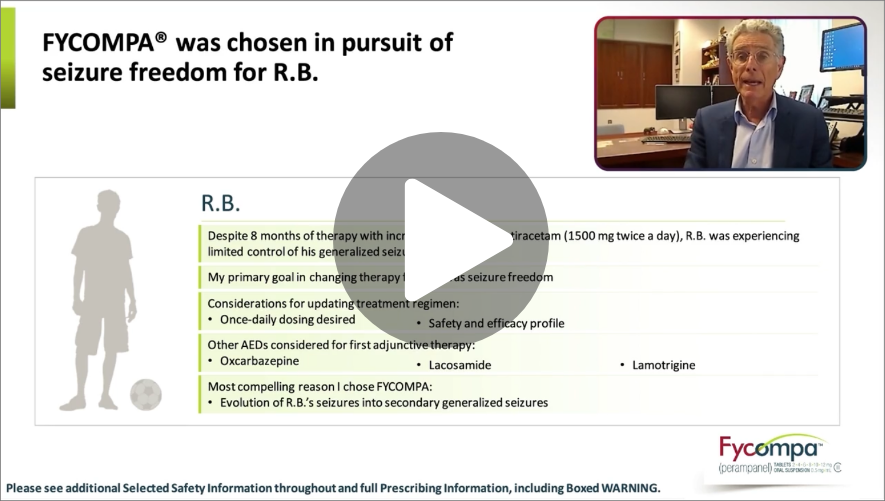[Intro music]
Najm: Hello. I am Imad Najm. I’m the director of the Epilepsy Center at the Cleveland Clinic in Cleveland, Ohio.
I am joined by Dr. Amir Arain, Professor of Neurology and head of the epilepsy division at the University of Utah, and Dr. Trevor Resnick, a pediatric epileptologist in the Comprehensive Epilepsy Program at Nicklaus Children’s Hospital in Miami, Florida.
In this final chapter of a 3-part video series, we are going to talk about the dosing and pharmacokinetics data for perampanel, which is a schedule III controlled substance.
Before watching this video, be sure to familiarize yourself with the safety and efficacy data for perampanel by watching Chapter 1 of this series. Please also watch Chapter 2, in which our expert faculty discuss patient cases drawn from their clinics that feature perampanel as first adjunctive therapy after AED monotherapy failure.
To start, Dr. Arain, will you please remind our viewers of the indication and Boxed WARNING for perampanel?
Arain: Certainly. FYCOMPA, or perampanel, is indicated for partial-onset seizures with or without secondarily generalized seizures in patients aged 4 and older with epilepsy.
FYCOMPA is also indicated as adjunctive therapy for patients aged 12 and older for primary generalized tonic-clonic seizures.
FYCOMPA has a Boxed WARNING for serious psychiatric and behavioral reactions. Serious or life-threatening psychiatric and behavioral adverse reactions, including aggression, hostility, or irritability, anger, and homicidal ideation and threats have been reported in patients taking FYCOMPA.
These reactions occurred in patients with and without prior psychiatric history, prior aggressive behavior, or concomitant use of medications associated with hostility and aggression.
We need to advise our patients and their caregivers to contact a health care provider immediately if any of these reactions or changes in mood, behavior, or personality that are not typical of the patients are observed while taking FYCOMPA or after discontinuing FYCOMPA.
We should also closely monitor patients, particularly during the titration period and at higher doses of FYCOMPA. FYCOMPA should be reduced if these symptoms occur and should be discontinued immediately if symptoms are severe or are worsening.
I would ask that you please note important safety information about FYCOMPA within this video and please refer to the full prescribing information for FYCOMPA, as well.
Najm: Thank you, Dr. Arain. Now, we are eager to discuss the dosing and pharmacokinetics data for perampanel. Dr. Resnick, will you please start us off by reviewing the dosing information?
Resnick: Sure. So if we look at FYCOMPA dosing, the message is, first of all, to start the dose low and go up slowly. We can see in the data from the FAME study, and also in the pivotal studies, that a good response in terms of efficacy can be seen as early as 4 milligrams.
So the message is to start the patients at 2 milligrams, increase to 4 milligrams, and then stop. Stop and assess the patients at 4 milligrams before increasing to higher doses such as 6, 8, 10, or 12 milligrams, depending upon the clinical response and tolerability.
As you can see on the right-hand side of the graphic, FYCOMPA is available in various dosage formulations, including 2, 4, 6, 8, 10, and 12 milligrams as well as an oral suspension, which is at a dose of 0.5 milligrams per milliliter.
For pediatric neurologists, it’s always very helpful when the doses are exactly the same in pediatric patients as they are in adults.
Now, as it relates to dosing and administration in specific populations, we already mentioned that FYCOMPA should be started at a dose of 2 milligrams per day at bedtime, but dosage adjustments in specific populations should be based on clinical response and tolerability.
For patients with mild or moderate hepatic impairment, a dosage adjustment is recommended, while caution is recommended when using FYCOMPA in patients with moderate renal impairment. The use of FYCOMPA in patients with severe hepatic or severe renal impairment is not recommended.
In the elderly population, the dosage increases should occur no more frequently than every 2 weeks during titration. So again, start low and go slow.
Najm: Thank you, Dr. Resnick. Now this graphic gives us an indication that missed doses are a persistent challenge not just in adults, but in children and adolescents, as well.
The number one reason for breakthrough seizures is a missed dose of antiepileptic medication, and the risk for breakthrough seizures rises when the plasma levels of antiepileptic drugs fall outside of the therapeutic range.
Dr. Arain, would you please give us an overview of the pharmacokinetics of perampanel?
Arain: Yes. Now FYCOMPA has a long half-life, up to 105 hours, based upon a model of 4 milligrams daily over a period of 4 weeks. The long half-life of FYCOMPA was established in Phase 1 clinical trials in healthy adults.
In pediatric patients aged 4 to 11 years, the half-life of FYCOMPA is long but is reduced by almost half.
In addition, in the presence of concomitant moderate or strong CYP3A4 enzyme inducers, the plasma half-life is also reduced by about 50%.
Now, the time to maximum serum concentration with FYCOMPA, as you can see in this diagram, ranges between a half hour and two and a half hours under fasting conditions.
FYCOMPA, as we’ve discussed, is dosed once daily, and you need to allow sufficient time to evaluate the effect of any dose change because, as you see in this diagram, it takes 2 to 3 weeks to achieve steady state.
Let’s discuss the impact of a long half-life and the effect of a missed dose on FYCOMPA plasma concentration. So this is a PK model that was constructed to explore the effects of a missed dose on FYCOMPA steady-state plasma concentrations.
A non-linear mixed-effects program was used for the PK modeling, and the simulations were done for adult patients receiving 8 milligrams per day of FYCOMPA. And the PK parameters were derived from data from 19 Phase 1 FYCOMPA trials.
The results of the study are limited because the PK model is based upon simulations and not on prospective clinical studies in humans. So further studies may be needed to replicate these findings.
Now, these 2 diagrams illustrate what happens to plasma levels in the event of a missed dose of FYCOMPA and the fluctuations that will occur in plasma levels in 2 different scenarios.
The first scenario, on the left, is in those patients who were not on concomitant enzyme-inducing AEDs, and the scenario on the right is in those patients who were on concomitant carbamazepine.
So, FYCOMPA has relatively low peak-to-trough fluctuations, which indicates that the concentration will remain relatively stable throughout the dosing interval. These simulated concentration-time profiles were based on adult patients who were taking 8 milligrams daily.
The graph on the left demonstrates modeled FYCOMPA plasma exposure in a patient who is not on concomitant enzyme-inducing AEDs who has missed a dose on day 15 and then resumed regular dosing the following day. So on day 15, as you see from the diagram, the trough concentration declines by around 18%, and the peak concentration declines by 12%.
Within 5 to 7 days after the missed dose, the modeled FYCOMPA exposure was very close to that of the patient who did not miss a dose. In other words, back to baseline.
The graph on the right demonstrates modeled FYCOMPA plasma concentration in a patient who is on concomitant carbamazepine and who has missed a dose, again on day 15, and then resumed the regular dosing the following day. As you can see from the diagram, the trough concentration declines by 44%, and the peak concentration decreases by 15%.
However, within 3 to 4 days of the missed dose, the modeled FYCOMPA exposure in this scenario ends up being very close to the baseline for the patient who did not miss a dose.
Remember that per the prescribing information, FYCOMPA should be administered once daily at bedtime. So patients who do miss a dose should just resume dosing the following day at their prescribed dose at the prescribed time.
And you need to instruct patients that that’s what they need to do, and if they miss more than 1 day, they should contact their health care provider.
Najm: Thank you, Dr. Arain, for sharing that information with us. Now Dr. Resnick, would you please review the Selected Safety Information for perampanel?
Resnick: Of course. In the partial-onset seizures clinical trials hostility and aggression-related adverse reactions occurred in 12% and 20% of patients randomized to receive FYCOMPA at doses of 8 and 12 milligrams per day, respectively. This is compared to 6% of patients in the placebo group.
These effects were dose related and generally appeared within the first 6 weeks of treatment, although new events continued to be observed through more than 37 weeks. These effects led to dose reduction, interruption, and discontinuation.
Now, the combination of alcohol and FYCOMPA significantly worsened mood and increased anger. Therefore, patients should avoid the use of alcohol while taking FYCOMPA.
Patients, their caregivers, and families should be informed that FYCOMPA may increase the risk of psychiatric events, and patients should be monitored during treatment with FYCOMPA, especially when taking higher doses of the medication.
Antiepileptic drugs, including FYCOMPA, increase the risk of suicidal thoughts or behavior in patients with epilepsy.
Patients, their caregivers, and families should be informed of the risk and advised to monitor and immediately report the emergence or worsening of depression, suicidal thoughts and behavior, thoughts about self-harm, and/or any unusual changes in mood or behavior.
FYCOMPA caused dose-related increases in events related to dizziness and disturbance in gait or coordination, especially during the titration phase, which is the most important phase of starting a medication.
FYCOMPA caused dose-dependent increases in somnolence and fatigue-related events, especially during the titration phase.
Patients should be advised against engaging in hazardous activities requiring mental alertness such as operating motor vehicles or dangerous machinery until the effect of FYCOMPA is known.
Patients should be carefully observed for signs of central nervous system depression when FYCOMPA is used with other drugs with sedative properties because of the potential additive effects.
Falls were more common in patients taking FYCOMPA at doses of 8 and 12 milligrams versus placebo, which as we know are the higher doses of FYCOMPA.
Drug reaction with eosinophilia and systemic symptoms, also known as DRESS or multiorgan hypersensitivity, has been reported in patients taking AEDs including FYCOMPA. DRESS may be fatal or life-threatening. We should always evaluate our patients if these signs or symptoms are present.
A gradual withdrawal is generally recommended with AEDs to minimize the potential of increased seizure frequency.
Now, the most common adverse reactions include dizziness, somnolence, fatigue, irritability, falls, weight gain, nausea, vertigo, headache, ataxia, vomiting, contusion, abdominal pain, and anxiety.
FYCOMPA may also decrease the efficacy of contraceptives containing levonorgestrel.
Plasma levels of FYCOMPA were decreased when administered with moderate or strong CYP3A4 inducers.
FYCOMPA may enhance the effects of alcohol on vigilance, alertness, anger, confusion, and depression.
These effects may also be seen when FYCOMPA is used in combination with other central nervous system depressants.
Therefore, caution should be exercised when FYCOMPA is administered to pregnant or nursing women.
Resnick: Use in patients with severe hepatic or severe impairment is not recommended.
Dosage adjustments are recommended in patients with mild or moderate hepatic impairment.
Use with caution in patients with moderate renal impairment.
Finally, FYCOMPA is a schedule III controlled substance and has the potential to be abused and lead to drug dependence and withdrawal symptoms.
And again, we encourage you to review the FYCOMPA full prescribing information, including Boxed WARNING.
Najm: Thank you, Dr. Resnick and Dr. Arain, for sharing this valuable information with us.
And to our viewers, thank you for joining us today. For more information, please be sure to visit FycompaOnDemand.com.
If you have not done so already, please be sure to watch Chapters 1 and 2 in this series to help you better understand the efficacy of perampanel in patients with partial-onset seizures and the ways in which perampanel might be incorporated into clinical practice.





